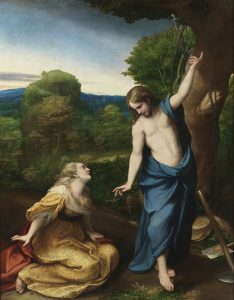Thoughts on Sunday’s Lessons for April 12, 2020
First Reading: Jeremiah 31:1-6
Easter is here! Christ is risen! The Lord is risen indeed, alleluia! We shout “alleluia,” literally “praise God,” as we celebrate the resurrection and its promise of victory over death.

“Noli me tangere” (“Do not hold on to me,” John 20:17), oil painting on canvas (c.1525) by Antonio da Correggio (1489-1534). Museo del Prado, Madrid. (Click image to enlarge.)
All our Easter Sunday readings speak of renewed life and joy. In this first reading the prophet Jeremiah imagines a joyful scene of dance and music as the people return home to Jerusalem from exile in Babylon. They look forward to re-planting the land in new vineyards that will bear delicious fruit.
Alternate First Reading or Second Reading: Acts 10:34-43
In the Acts of the Apostles the evangelist Luke tells how Christianity reached out from its Jewish beginnings to incorporate all humankind. That story begins in this reading as we see Peter taking the gospel for the first time to a gentile family. Visiting the household of the centurion Cornelius, a ranking Roman army officer yet a good man and a believer, Peter assures them that Jesus was sent by God to all humanity, was crucified but raised from the dead, and now saves us and forgives our sins in God’s name.
Psalm: Psalm 118:1-2, 14-24
This ancient hymn sings Israel’s joyful thanks to God for victory over its enemies, and our Jewish brothers and sisters traditionally read it during Passover, which begins Wednesday, April 8, and continues through next Thursday. Christians may also imagine an image of Jesus in the prophetic words, “The stone that the builders rejected has become the chief cornerstone.” These verses shout out the hope of an Easter people: “I shall not die, but I shall live … The Lord … did not give me over to death. … I thank you that you have answered me and have become my salvation.”
Second Reading: Colossians 3:1-4
Even in difficult times, Christ is with us, this short letter assures the persecuted Christians of Colossae in Turkey. Just as Jesus was raised from the dead, Christians are connected in baptism and raised through life in Christ, its author writing in Paul’s name assures the people. The following verses urge the people to endure their difficulties with patience and the strength that comes from God’s glorious power expressed through Jesus – not in a distant second coming but in the here and now.
Gospel: John 20:1-18 or Matthew 28:1-10
Just as multiple witnesses to any amazing event will recall details differently, each of the four evangelists differs somewhat in his account of Jesus’ friends finding the empty tomb. In the two Gospels that may be read in this lectionary year, John’s version tells us that only Mary Magdalene was there. John portrays her, in beautifully tender verses, as the only one who stayed at the empty tomb after everyone else left. Then, to her joyful delight, Jesus greeted her by name! In Matthew’s account, it’s the group of women who encounter the risen Christ. He greets them, they fall at his feet to worship him, and he tells them to go back and direct the men to go to Galilee to see Jesus there.
